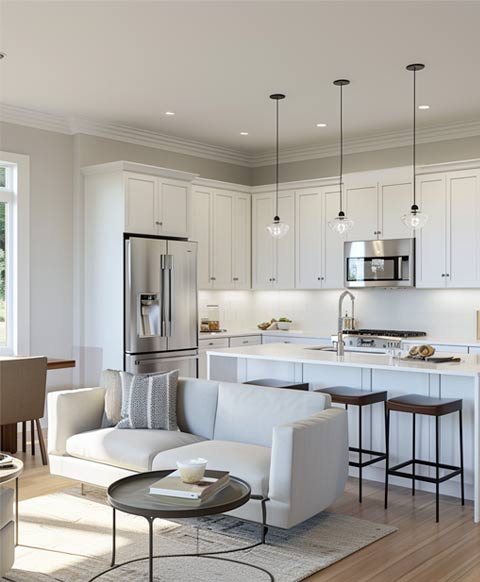In California, the process to build an accessory dwelling unit (ADU)—also known as a guest house, granny flat, casita, additional unit, or in-law suite—on residential properties has been greatly streamlined. This development prompts the question: Is an ADU a valuable investment? More specifically, does adding an ADU increase the value of your home in California? For both seasoned investors and homeowners venturing into rental income for the first time, the answer varies based on multiple considerations. Granny Homes is here to help you explore the potential benefits and considerations of adding an ADU to your property in the Greater Sacramento and Bay Area, aiming to enhance your property’s value and appeal in California’s competitive real estate market.
Is an ADU a good investment?
For numerous homeowners, investing in an accessory dwelling unit (ADU) represents a robust investment opportunity. To evaluate if an ADU aligns with your investment goals, it’s crucial to grasp the construction costs associated with the desired size of the unit. Delve into the specifics of ADU construction expenses to get started. Following that, gaining insight into how an ADU could potentially enhance your property’s value and boost rental income is essential, along with understanding the tax implications associated with ADUs. Granny Homes is committed to guiding you through these aspects, ensuring you’re well-informed about the financial dynamics of adding an ADU to your property in the Greater Sacramento and Bay Area, maximizing your investment’s value and profitability.
For example, when constructing an ADU on your primary residence, you benefit from a significant tax advantage upon selling the property. Homeowners can exclude up to $250,000 of capital gains from taxes when selling their primary residence, or up to $500,000 for married couples filing jointly. This contrasts with a separate investment property, which doesn’t qualify as your primary residence, highlighting the unique tax shelter an ADU offers. Adding an ADU to your primary residence in the Greater Sacramento and Bay Area not only increases your property’s functionality and potential rental income but also provides a tax-efficient strategy for when it’s time to sell, enhancing the overall value of your investment with Granny Homes.
Read on for our thoughts on all the considerations when assessing if it is worth it to build a guest house on your property and how to value building an ADU.
How much does an ADU increase property value?
In the broader context of real estate, the added value of an ADU is influenced by comparable sales in your locality. Research, such as a study conducted by Porch, reveals that in major cities, properties equipped with an ADU generally command a price premium of 35% over those without one. This significant margin underscores the economic advantage and appeal of adding an ADU to your property, particularly in the competitive markets of the Greater Sacramento and Bay Area. By incorporating an ADU, Granny Homes helps homeowners not only enhance their property’s utility and earning potential but also significantly increase its market value, aligning with the latest trends and data in real estate investments.
Adding an ADU to your property is a strategic move that usually boosts its resale value. This is because homes equipped with ADUs are appraised alongside similar properties that also feature additional units. Appraisers consider the value of properties with ADUs to establish the worth of your home. Properties featuring an ADU often command a higher price on the market due to the income-generating potential of the unit and the increased square footage of livable space they provide. In the Greater Sacramento and Bay Area markets, where demand for versatile and functional living spaces is high, incorporating an ADU with Granny Homes can significantly enhance your property’s appeal and financial value, making it a wise investment in today’s real estate landscape.
While we are still early in the adoption of ADUs on a wide scale, it is becoming easier to find properties sold with guest houses. New appraisal guidelines are also making it possible for appraisers to include ADUs as part of their assessment of a property, which should start leading to more consistent valuations for ADUs.
A permitted ADU may be added to your title insurance report and will invariably increase your property’s value, both for the increase in square footage and as an income producing property. A tiny home or an unpermitted ADU will not be picked up on a title report and the property owner will only realize the value of the income production from renting the unit.
How much value does an ADU add in California?
To determine ADU value, one rule of thumb we’ve seen used is that a newly constructed accessory dwelling unit will add 100 times the monthly rental value to your home. So if an ADU will be rented out for $3,500 a month, it might add around $350,000 to the value of the home. So, does an ADU add value to your home in California? Yes, but this will of course vary widely on a case by case basis.
Sherry Chen, a seasoned ADU specialist and Realtor with Compass, offers insightful advice for those deliberating on the construction of an ADU. She emphasizes, “An ADU is a strategic investment for individuals seeking immediate valuable cash flow, along with the prospect of long-term property appreciation over a period of at least three to five years.” Chen advises that if the intention is to sell the property in a shorter timeframe, there’s a possibility that the return on investment (ROI) may not fully materialize. This perspective is especially relevant for property owners in the Greater Sacramento and Bay Area, where Granny Homes operates. The advice underscores the importance of aligning ADU investments with your financial and timing objectives to maximize benefits.
How will an unpermitted ADU affect my property value?
Opting to reduce expenses during the construction of your ADU might seem appealing, and the idea of building an unpermitted ADU, particularly for those with the skills to do so over weekends, is a question many homeowners contemplate. However, it’s crucial to consider the long-term implications of such a decision. An unpermitted ADU can lead to a range of challenges, including potential legal issues, difficulties in securing insurance, and complications when selling or refinancing your property. Furthermore, an unpermitted ADU may not be included in the property’s official valuation, affecting its market value and the ability to leverage it for income generation. At Granny Homes, serving the Greater Sacramento and Bay Area, we stress the importance of adhering to local regulations and obtaining the necessary permits before embarking on the construction of an ADU. This ensures your investment adds tangible value to your property and remains a viable, profitable asset for years to come.
A crucial aspect often overlooked is the impact of an unpermitted ADU on the appraisal of your property. If the accessory dwelling unit isn’t officially recognized, it won’t be considered in the property’s appraisal, potentially narrowing your pool of prospective buyers when you decide to sell. Most buyers rely on financing, necessitating that the home’s appraised value meets or exceeds the agreed purchase price for loan approval. Constructing a permitted ADU ensures that the unit’s value is factored into the appraisal, significantly enhancing the property’s marketability and appeal. This strategic move not only attracts more competitive offers but also simplifies the selling process, making it a smoother, more profitable transaction. For homeowners in the Greater Sacramento and Bay Area, Granny Homes emphasizes the importance of securing the necessary permits for your ADU, thereby ensuring it contributes positively to your property’s value and attractiveness in the real estate market.
Further, having an ADU helps the property appraisal when refinancing the home, which may provide homeowners with equity they otherwise wouldn’t have had available.
What is the return on investment (ROI) for an ADU?
ADUs offer a compelling return on investment, particularly from a cash flow standpoint. Consider the example of a 1000 square foot ADU with 3 bedrooms and 2 bathrooms. The all-inclusive cost for design, permits, site work, construction, and typical other improvements such as utilities is approximately $430,000. This investment can yield significant rental income, with the potential to rent for over $4,500 per month. This scenario highlights the financial viability of ADUs as an investment strategy, especially in regions like the Greater Sacramento and Bay Area, where rental markets are strong. By investing in a well-planned ADU with Granny Homes, homeowners can unlock a lucrative source of continuous income, enhancing their property’s value and generating substantial cash flow over time.
When thinking about your true return on investment, be sure to budget for maintenance costs, taxes, and insurance. In this example above, that’s still close to $45,000 per year in your pocket. Unleveraged cash-on-cash returns would easily hit 10% on the full build cost of the ADU. You could also finance the construction; even at a rate of 8% in the above example, you would net $8,200 annually if you financed all of the construction and came out of pocket just for design & permits (about $20,000). That’s an ROI of 41% on your invested capital in the ADU project.
Refinancing at a more favorable rate down the road would further boost these returns. Moreover, this analysis doesn’t even take into account the property value appreciation due to the added ADU, which offers additional financial upside when you decide to sell.







